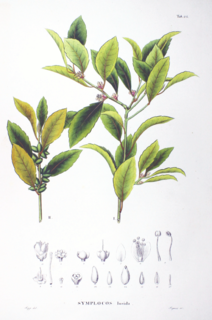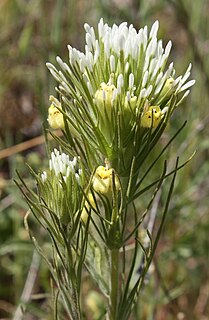
Flax, also known as common flax or linseed, is a flowering plant, Linum usitatissimum, in the family Linaceae. It is cultivated as a food and fiber crop in regions of the world with temperate climates. Textiles made from flax are known in Western countries as linen and are traditionally used for bed sheets, underclothes, and table linen. Its oil is known as linseed oil. In addition to referring to the plant, the word "flax" may refer to the unspun fibers of the flax plant. The plant species is known only as a cultivated plant and appears to have been domesticated just once from the wild species Linum bienne, called pale flax. The plants "flax" in New Zealand are, by contrast, members of the genus Phormium.

Linum (flax) is a genus of approximately 200 species in the flowering plant family Linaceae. They are native to temperate and subtropical regions of the world. The genus includes the common flax, the bast fibre of which is used to produce linen and the seeds to produce linseed oil.

Hypericaceae is a plant family in the order Malpighiales, comprising six to nine genera and up to 700 species, and commonly known as the St. John's wort family. Members are found throughout the world apart from extremely cold or dry habitats. Hypericum and Triadenum occur in temperate regions but other genera are mostly tropical.

Linaria vulgaris, the common toadflax, yellow toadflax or butter-and-eggs, is a species of flowering plant in the family Plantaginaceae, native to Europe, Siberia and Central Asia. It has also been introduced and is now common in North America.

Hesperolinon is a genus in the family Linaceae, whose common genus names are dwarf-flax or western flax, in reference to their distribution along the west coast of North America. There are 13 known species within this genus of wildflowers, most of which are limited to serpentine soil habitats within California, United States. These annual plants are thought to be mostly self-pollinating.

Hesperolinon congestum, or Marin dwarf flax, is an annual herb, which is known to occur only in San Mateo, San Francisco and Marin County, California, United States. This plant occurs chiefly on serpentine soils, especially in dry native bunch grasses, chaparral or other grasslands at elevations less than 200 meters. The flowers are congested at the tips of the dichotomously branching stems. H. congestum is in flower between April and July. The outlook for this plant depends on survival of only about twenty small colonies, most of which are not actively managed for protection, even though the species is federally and state-listed as threatened. This species is also less commonly known as Marin western flax.

Doronicum grandiflorum is a European species of Doronicum, a member of the family Asteraceae.

Symplocaceae is a family of flowering plants in the order Ericales, including two genera, Symplocos and Cordyloblaste, totalling about 260 known species. The common name for Symplocaceae is sweetleaf. Symplocaceae has a transpacific distribution that covers the Southeast United States, South America, Southeast Asia and Northern Australia. Plants in the family Symplocaceae are generally trees or shrubs, and are found in humid, tropical, montane forests within their range.

Hesperolinon breweri is a rare species of flowering plant in the flax family known by the common names Brewer's dwarf flax and Brewer's western flax. It is endemic to California, where it is known from three counties in the San Francisco Bay Area. It is found in chaparral ecosystems, often on serpentine soils. This is an annual herb growing erect to a maximum height near centimeters. Its narrow, linear leaves are greenish to purplish in color. It produces dense inflorescences of flowers with glandular sepals and five bright yellow petals. The protruding stamens hold large orange-yellow anthers. This uncommon California endemic is threatened by development of its habitat but its current status is not known.
Hesperolinon californicum is a species of flowering plant in the flax family known by the common name California dwarf flax. It is endemic to California, where it grows in the coastal mountains and hills surrounding the San Francisco Bay Area and some of the foothills of the Sierra Nevada. It is found in grassland and chaparral ecosystems, often on serpentine soils. This is an annual herb growing erect to 10 to 25 centimeters in height. It has thin, narrow to threadlike leaves and produces a red exudate from resin glands located at the base of leaf petioles. The inflorescence holds several flowers with glandular sepals and five white to pink-tinged petals. The protruding stamens are tipped with large pink anthers.
Hesperolinon drymarioides is a rare species of flowering plant in the flax family known by the common names drymary dwarf flax and drymaria-like western flax; it is named for its resemblance to genus Drymaria. It is endemic to California, where it grows in the central inland North Coast Range. Most of the few known occurrences have been noted in Lake County. It is a plant of serpentine soils in chaparral and woodland ecosystems. This is a small annual herb growing a thin branching brown stem low to the ground or erect to about 20 centimeters in height. Leaves appear in whorls of four on the lower part of the stem and are dark reddish green with plentiful glandular hairs. Its flowers have light pink-veined white petals in a corolla about a centimeter across. Protruding stamens hold large yellow or purplish-white anthers.
Heteranthemis is a monotypic genus of plants in the daisy family containing the single species Heteranthemis viscidehirta, which is known by the common name oxeye, or sticky oxeye. This plant is native to the Iberian Peninsula and adjacent areas in North Africa, but it can be found in other parts of the world as an introduced species. This is an annual herb growing erect stems 20 to 80 centimeters tall. Its abundant leaves are a few centimeters long, wavy to curly and divided into irregular toothed lobes. The stem and foliage are glandular and produce a sticky exudate. The plants produce bright yellow daisylike flower heads, with bases covered in large green phyllaries. The center of the head is filled with many yellow disc florets and the edge is fringed with toothed yellow ray florets about 2 centimeters long.
Lagophylla glandulosa is a species of flowering plant in the family Asteraceae known by the common name glandular hareleaf. It is endemic to California, where it grows in the Central Valley and foothills in chaparral, grassland and woodland habitat. This is an annual herb growing a very thin stem covered in glandular hairs, especially at the top in the inflorescence. The leaves are mostly small, smooth-edged, and glandular-hairy on the top of the stem, with much larger, toothed leaves toward the base. The inflorescence bears flower heads with five bright yellow ray florets, each with three lobes. The center of the head contains six disc florets which are yellow with black anthers. The fruit is a dark brown achene with no pappus.

Castilleja lineariiloba is a species of Indian paintbrush known by the common name sagebrush Indian paintbrush that is endemic to the grasslands of the Sierra Nevada foothills in California.

Hesperolinon disjunctum is a species of flowering plant in the flax family known by the common name Coast Range dwarf flax. It is endemic to California, where it has a disjunct distribution along the North and Central Coast Ranges.

Linum puberulum is a species of flax known by the common name plains flax. It is native to the western and midwestern United States from California to Nebraska to Texas, where it grows in dry, open habitat including desert, semi-desert, hills and low mountains. It is a downy-haired perennial herb producing an erect, branching stem lined with glandular linear leaves up to about 1 centimeter long. The inflorescence is a wide open cyme of golden yellow to yellow-orange flowers each with five petals 1 to 1.5 centimeters in length. The fruit is a capsule about 4 millimeters wide.

Vancouveria chrysantha is a species of flowering plant in the barberry family known by the common names golden inside-out flower and Siskiyou inside-out flower.

Phormium is a genus of two plant species in the family Asphodelaceae. One species is endemic to New Zealand and the other is native to New Zealand and Norfolk Island. The two species are widely known in New Zealand as flax or their Māori names wharariki and harakeke respectively, and elsewhere as New Zealand flax or flax lily, but they are not closely related to the Northern Hemisphere's flax, which is native to the region extending from the eastern Mediterranean to India and has been used by humans since 30,000 B.C.
Persoonia spathulata is a species of flowering plant in the family Proteaceae and is endemic to the south-west of Western Australia. It is an erect to spreading shrub with hairy young branchlets, spatula-shaped leaves, and yellow flowers arranged singly or in pairs on a rachis up to 2 mm (0.079 in) long that continues to grow after flowering.

North American azaleas are flowering shrubs in the genus Rhododendron, section Pentanthera, subsection Pentanthera, so named because they all have five stamens. Most are in the United States, with one species found in Canada and one being found in Mexico. North American azaleas are commonly confused with azaleas of Asian origin, the evergreen azaleas. North American azaleas are deciduous and produce two types of buds. One is a larger and produces about 20 flowers while the other bud produces a leafy shoot. The flower color, fragrance, and number of stamens vary among species.















